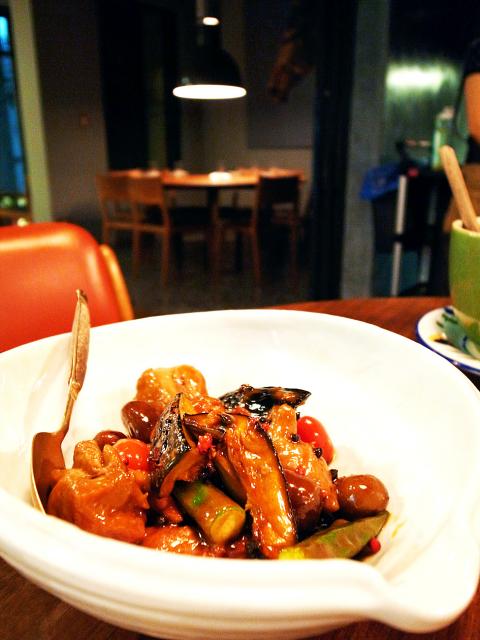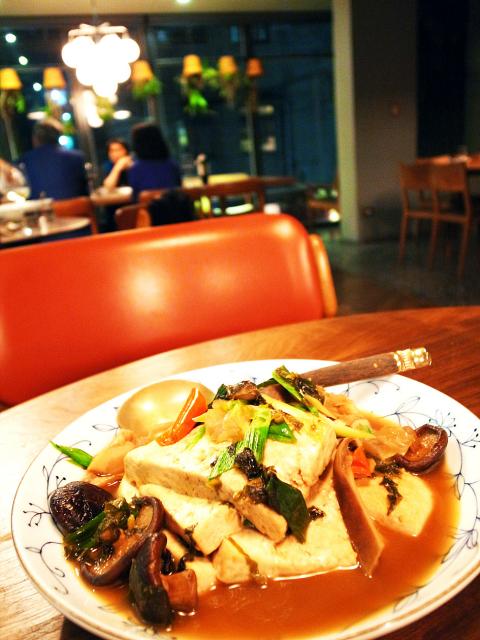From the makers of Szuchihtang (四知堂) comes Tua (攤), where traditional Taiwanese dishes undergo a modern makeover. The idea behind Tua — which means having a dinner date with friends in Hoklo (commonly known as Taiwanese) — is to elevate Taiwanese cuisine to something more stylish and upscale. While other establishments in Taipei have toyed with the concept, so far, it’s just Tua that has succeeded.
The two-story establishment doesn’t have a sign and can be easily mistaken for a private residence with a well-attended front garden. Inside, it has the feel of a design-savvy bistro, a cross between industrial and vintage-chic. Sapphire-blue and grayish-silver paintings lend the space some playful charm.
The waitresses are mainly young ladies in aprons, and the one who waited on us knew the food well and made useful suggestions.

Photo: Ho Yi, Taipei Times
Although the menu is short, it includes a delectable selection of Taiwanese-fusion food. Diners are even provided with a choice of sparkling/non-sparkling mineral water (NT$100).
My dining partner and I began our meal with the stewed beef (NT$250), an appetizer substantial enough to be served as a main course. The meat was well-marinated and flavorful, with a hint of soy sauce.
The three-flavored chicken (NT$650), which consists of cherry tomatoes, mushroom, okra, Sichuan peppercorns and, of course, the savory chicken was equally zesty.

Photo: Ho Yi, Taipei Times
The braised tofu with pork intestines and pickled mustard tuber ($480) were surprsingly subtle in flavor, but perhaps it was because the sprinkling of sliced pickles, scallions and chili helped to drown out the usually overpowering flavor of the intestines.
While all the dishes we tried were more or less satisfying, the seafood rice noodles (NT$500) takes the prize. Usually cooked as street food, the rice noodles were refined with an abundance of shrimps, oysters and clams.
Other popular dishes on the menu — which changes seasonally — includes the three cup pork knuckle (NT$650) and almond and black fungus with bamboo shoots (NT$550).

Photo: Ho Yi, Taipei Times
We were too full for desserts but were still treated to a helping of baked sweet potatoes with cream cheese and caramel on the house. They were as sweet and delectable as they sound.
For tipplers, the restaurant’s cellar consists of red, white and sparkling wine from Chile, France and Germany, priced between NT$900 to NT$2,000.
Overall, Tua is a good spot to bring non-Taiwanese friends and show them that local fare can, too, be swanky.

That US assistance was a model for Taiwan’s spectacular development success was early recognized by policymakers and analysts. In a report to the US Congress for the fiscal year 1962, former President John F. Kennedy noted Taiwan’s “rapid economic growth,” was “producing a substantial net gain in living.” Kennedy had a stake in Taiwan’s achievements and the US’ official development assistance (ODA) in general: In September 1961, his entreaty to make the 1960s a “decade of development,” and an accompanying proposal for dedicated legislation to this end, had been formalized by congressional passage of the Foreign Assistance Act. Two

Despite the intense sunshine, we were hardly breaking a sweat as we cruised along the flat, dedicated bike lane, well protected from the heat by a canopy of trees. The electric assist on the bikes likely made a difference, too. Far removed from the bustle and noise of the Taichung traffic, we admired the serene rural scenery, making our way over rivers, alongside rice paddies and through pear orchards. Our route for the day covered two bike paths that connect in Fengyuan District (豐原) and are best done together. The Hou-Feng Bike Path (后豐鐵馬道) runs southward from Houli District (后里) while the

March 31 to April 6 On May 13, 1950, National Taiwan University Hospital otolaryngologist Su You-peng (蘇友鵬) was summoned to the director’s office. He thought someone had complained about him practicing the violin at night, but when he entered the room, he knew something was terribly wrong. He saw several burly men who appeared to be government secret agents, and three other resident doctors: internist Hsu Chiang (許強), dermatologist Hu Pao-chen (胡寶珍) and ophthalmologist Hu Hsin-lin (胡鑫麟). They were handcuffed, herded onto two jeeps and taken to the Secrecy Bureau (保密局) for questioning. Su was still in his doctor’s robes at

Mirror mirror on the wall, what’s the fairest Disney live-action remake of them all? Wait, mirror. Hold on a second. Maybe choosing from the likes of Alice in Wonderland (2010), Mulan (2020) and The Lion King (2019) isn’t such a good idea. Mirror, on second thought, what’s on Netflix? Even the most devoted fans would have to acknowledge that these have not been the most illustrious illustrations of Disney magic. At their best (Pete’s Dragon? Cinderella?) they breathe life into old classics that could use a little updating. At their worst, well, blue Will Smith. Given the rapacious rate of remakes in modern